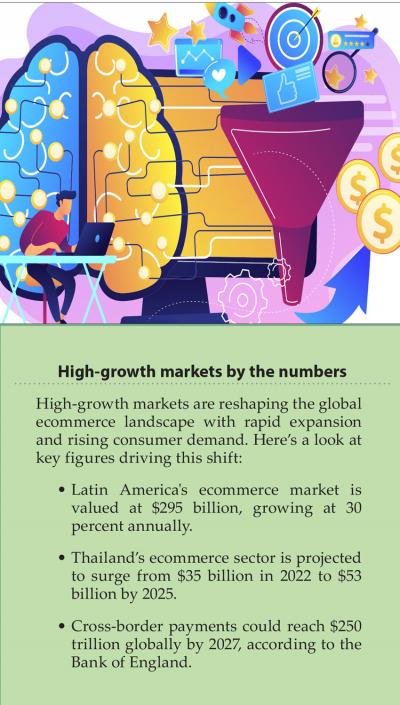The Green Sheet Online Edition
April 4, 2025 • 25:04:02
Unlocking ecommerce growth in high-growth markets

The ever-broadening landscape of cross-border payments continues to reshape global ecommerce, creating new competitive opportunities for high-growth markets. Historically led by the United States and Europe, the global payment sector is now witnessing a surge of advancements in Asia and Latin America.
Efficient payment solutions are pivotal in this transformation, as they are often seen as potential barriers to growth if not effectively implemented. By adopting seamless and innovative payment solutions, Asia and Latin America are overcoming these challenges, significantly influencing the global ecommerce industry.
As Asia and Latin America establish themselves as global ecommerce powerhouses, they demonstrate unmatched growth and technological advancements with ecommerce growth rates of approximately 30 percent.
The widespread adoption of ecommerce and mobile commerce, driven by efficient payment systems, is fueling this expansion. The shift toward mobile-first shopping further accelerates growth, as enhanced mobile usage and improved internet connectivity facilitate smoother cross-border transactions, encouraging greater participation in the global ecommerce market.
In contrast, established markets like the United States and Europe continue to see steady but slower growth, with annual increases of 7 to 12 percent. Despite their advanced infrastructures, their growth rates lag behind the rapid expansion seen in Asia and Latin America.
This disparity underscores the diverse and vibrant nature of the global ecommerce landscape, highlighting the crucial role efficient payment systems play in enabling regions to engage and thrive in the global ecosystem actively. As these markets continue to develop and integrate cutting-edge payment technologies, they are poised to redefine the future of digital commerce on a global scale.
Explosive growth and future potential in high-growth markets
High-growth markets are not just expanding rapidly; they offer vast potential for future growth. The Bank of England anticipates the cross-border payments market could soar to $250 trillion by 2027, spotlighting enormous opportunities within these regions.
Latin America is a shining example, with its ecommerce market valued at $295 billion and growing at 30 percent. This surge is fueled by increasing digital connectivity and consumer purchasing power, driven by improved infrastructure and a burgeoning middle class.
Asia is also witnessing extraordinary growth. In Thailand, the ecommerce market is expected to escalate from $35 billion in 2022 to $53 billion by 2025. Innovations in international payment methods are making cross-border transactions more accessible, propelling this boom. Countries such as Indonesia are leveraging technology to enhance their digital ecosystems, spurring both ecommerce and fintech advancements.
These trends underscore the immense potential of these regions as prime markets for cross-border ecommerce. With technology evolving and online shopping on the rise, these regions are set to redefine the global ecommerce landscape.
To seize these opportunities, businesses must delve into these dynamic markets and tailor their strategies, securing a formidable position in digital commerce.
Challenges and strategies for expanding to new markets
Tapping into the fast-growing ecommerce markets comes with its own set of hurdles. Each region boasts distinct payment systems, business climates and regulatory landscapes, making it imperative for businesses to grasp these intricacies thoroughly.
One prominent challenge is deciphering local consumer behaviors and payment preferences. Take Thailand, for instance, where bank transfers lead with 31 percent of transactions, while cards and e-wallets each hold 22 percent.
In contrast, in Latin America, although digital payments are gaining traction, cash still plays a significant role. This variation in payment preferences underscores the necessity for versatile and adaptable payment solutions. Companies that overlook these preferences risk missing out on substantial market opportunities.
Navigating the regulatory terrain presents another layer of complexity. Each market comes with its own financial regulations, compliance standards and legal stipulations. For instance, South Korea's currency, the won, cannot be moved out of the country, requiring currency conversion for international transactions.
Being well-versed in local laws related to issues like anti-money laundering, data protection and taxation is essential to avert legal complications and earn the trust of customers and partners.
Operational issues such as managing transaction approval rates, dealing with high interchange fees and handling currency fluctuations can affect profitability.
To overcome these challenges, businesses should collaborate with payment experts that can provide advanced payments technology, local payments expertise and solutions that can fit into a variety of different markets and industries.
Strategies for thriving in high-growth markets
In the global marketplace, a one-size-fits-all payment strategy falls short. Each market demands a nuanced approach due to its unique regulations, payment habits, and cultural quirks.
To thrive in international markets, businesses should consider partnering with a comprehensive payment service provider that offers a centralized view of payment activities across multiple regions. This approach simplifies the management of complex cross-border payment processes, enhances approval rates and reduces costs.
By leveraging a single provider's deep expertise in regulatory compliance and foreign exchange risk management, businesses can streamline operations and focus on growth. Centralized access to advanced reporting and reconciliation tools is crucial, enabling businesses to track performance and adapt strategies effectively, ensuring compliance with local regulations and maximizing their global reach.
As digital commerce continues to evolve, the spotlight shifts towards harnessing the untapped potential of high-growth markets. The growth trajectory in Asia and Latin America is not merely a trend but a testament to global economic change.
For businesses keen on expanding their horizons, these regions offer a gateway to new consumer bases, innovative practices, and a chance to be part of the dynamic future of ecommerce. 
Guillaume Tournand is vice president of growth at Worldline, where he expands the company?s unique selling proposition through geographical expansion, alternative payment methods and M&A. He has 20 years of experience in various positions, including IT/development, sales, marketing, product management, corporate development, and M&A/finance. Worldline has long recognized the shift toward harnessing the untapped potential of high-growth markets. It has been studying these markets and building relationships within local banking and payment ecosystems. The company is dedicated to aiding its customers in expanding globally and operating more efficiently in these vibrant areas. For more information, contact Guillaume via LinkedIn at www.linkedin.com/in/guillaume-tournand.
Notice to readers: These are archived articles. Contact information, links and other details may be out of date. We regret any inconvenience.





